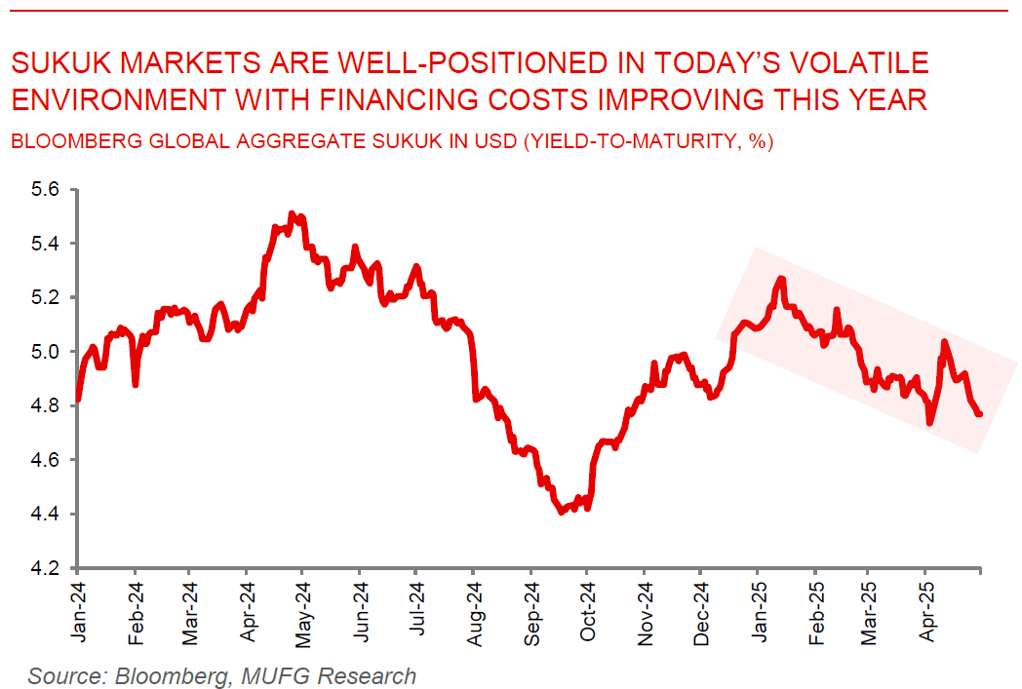To read the full report, please download the PDF above.
Middle East Daily
EHSAN KHOMAN
Head of Commodities, ESG and
Emerging Markets Research –
EMEA
DIFC Branch – Dubai
T:+971 (4)387 5033
E: ehsan.khoman@ae.mufg.jp
SOOJIN KIM
Research Analyst
DIFC Branch – Dubai
T: +44(4)387 5031
E: soojin.kim@ae.mufg.jp
MUFG Bank, Ltd. and MUFG Securities plc
A member of MUFG, a global financial group
Middle East Daily
GLOBAL MARKETS
US economy contracts as corporates front loaded imports ahead of tariffs. US Q1 2025 GDP contracted by 0.3% q/q annualised – first decline in output since Q2 2022. As anticipated, the net trade subcomponent registered the brunt of the weakness with corporate front loading imports ahead of the “Liberation Day” tariffs. Imports soared by an annualised 41.3% (largest advance in five years), whilst exports rose only by an annualised 1.8%. This collectively led to an acute rise in inventories, which added 2.25ppts to headline growth. Disconcertingly, the core PCE deflator increased by an higher-than-expected 3.5% – signalling more stickiness in inflation ahead of what is likely to be material tariff-induced negative supply shock that may have a persistent effect on inflation and expectations. On net, this has a distinctly stagflationary flavour.
Are we past the peak of new tariff shocks in global markets? Risk assets have managed a partial recovery from the lows reached on 8 April. A pivot in trade policy was the most clear route for the recovery in risk assets. We have witnessed some dimension of that, with (1) the 90 day pause on reciprocal tariffs; (2) product-specific tariff exemptions; and (3) seeming US openness to negotiating with China. Yet, these are, in our view, only modest shifts that still leave substantial tariffs and recessionary risks on the table. In past equity corrections, markets tended to bottom near the trough in economic activity. Based on consensus estimates, that does not take place until Q4 2025. The most critical question today is whether the current period is more like past shock-driven corrections where the tariff shock has peaked to call for a market bottom, or whether this will be a scenario where the data needs to stabilise first.
MACRO / MARKETS
Middle Eastern issuers tap debt markets as market appetite returns. In what was one of the busiest days for regional credit and Islamic debt this year, a trio of US dollar bond deals came to the market on 30 April, as issuers looked to take advantage of more constructive primary markets on the back of US Treasury rates rallying back. According to reports, Saudi’s Public Investment Fund (PIF) is looking to sell a USD1.25bn seven-year US dollar-denominated debt Islamic sukuk, while the UAE’s DP World is offering a USD1.5bn ten-year sukuk. Separately, Banque Saudi Fransi (BSF) priced USD650m of Additional Tier 1 notes. All in, the global sukuk ecosystem is on track to surpass USD1tn this year, with the GCC IG US dollar sukuk space remaining resolute, printing a record USD15bn in Q1 2025. The asset class has grown +10x over the past decade, reaching a record annual issuance of USD153bn in 2024.
CREDIT TRADING
End of day comment – 30 April 2025. The market was focused on new issues in the morning and early afternoon until US numbers injected some rates volatility, also affecting swap spreads. In the last two hours of trading, flows picked up significantly reflecting month end rebalancing from the account side. At the end-of-day, the IG sovereigns ADGB and QATAR are closing broadly unchanged in spreads +/- 2bp. With the afternoon steepening of US rates, there was renewed interest in 2029-35 maturities. On the new issue front, new ADQABU 35s closed +0.25pt/-2bp outperforming slightly new 30s. New ADNOCM 35s was bid up late afternoon and closed 99.50/75 (+0.25pt/-2bp) and it looks like lose bonds have now been absorbed. In higher beta names OMAN closed 5-10bp wider on the back of new BHRAIN issues, 32s was most active closing -0.5pt/+8bp. DPWDU launched its new 10y sukuk issue at T+145bp with the size set at 1.5bn. Broader risk markets sent a volatility reminder today, but GCC proved resilient against spread widening in credit indices. Flows are well balanced as well for now leaving the issuance window wide open.
COMMODITIES / ENERGY
Oil risks new lows on loosening fundamentals. Oil prices witnessed their largest decline since November 2021 last month, on signs of tepid global oil demand, with Brent crude once again testing the USD60s/b handle (USD58/b marked the recent low on 9 April). The US administration’s volatile tariff policy strategy, especially those involving China, has made traders that were already skittish on the longstanding oversupply this year (that pre-dates President Trump’s second term), nervous about loosening fundamentals. Exacerbating the bearish momentum, Reuters reported on 30 April, that Saudi Arabia official have been deliberating with allies that the Kingdom can endure a sustained period of lower prices. Today’s ongoing oil oversupply, coupled with heightened implied volatility, is prompting us to mark-to-market our Brent oil price levels lower to USD66/b (USD73/b prior) and USD62/b (USD76/b prior), in 2025 and 2026, respectively (see here).
Gold-backed ETFs surge on heightened global uncertainties. Investors on edge by the growing global trade war flocked to gold-backed ETFs in the Q1 2025, with inflows propelling bullion’s 19% rally in the three month period, according to the World Gold Council. Despite persistently notching fresh peaks, our conviction remains resolute that we are a distance away from overextended or bubble territory, and maintain our above consensus forecasts for gold to catapult even higher and hit USD3,850/oz by year-end and breach north of the USD4,000/oz threshold by Q2 2026 (see here).

